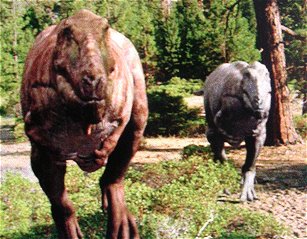

Systematics:
Dinosauria Owen, 1842
Theropoda Marsh, 1881
Carcharodontosauridae Stromer, 1931
Giganotosaurinae n. subfam.
Mapusaurus roseae n. gen.
Etymology: "Mapu" is a Mapuche (local indigenous people) term for Earth. Therefore "Mapusaurus" should be translated as "Earth reptile." The term "roseae" refers to the rose-colored rocks that surround the site where Mapusaurus n. gen. was found, and to Rose Letwin (Seattle) who sponsored the expeditions in 1999, 2000 and 2001.
Horizon and Locality: Huincul Formation, Río Limay Group (Cenomanian), of the Neuquén Group. Cañadón del Gato in the Cortaderas area 20 km southwest of Plaza Huincul, Neuquén Province, Argentina.
Abstract- A new carcharodontosaurid theropod from the Huincul Formation (Aptian- Cenomanian, Upper Cretaceous) of Neuquén Province, Argentina, is described. Approximately the same size as Giganotosaurus carolinii Coria & Salgado, 1995, Mapusaurus roseae n. gen., n. sp. is characterized by many features including a deep, short and narrow skull with relatively large triangular antorbital fossae, relatively small maxillary fenestra, and narrow, unfused rugose nasals. Mapusaurus roseae n. gen., n. sp. has cervical neural spines and distally tapering epipophyses, tall dorsal neural spines, central pleurocoels as far back as the first sacral vertebra, accessory caudal neural spines, stout humerus with poorly defined distal condyles, fused metacarpals, ilium with brevis fossa extending deeply into ischial peduncle, and femur with low fourth trochanter.
Phylogenetic analysis indicates that Mapusaurus n. gen. shares with Carcharodontosaurus Stromer, 1931 and Giganotosaurus Coria & Salgado, 1995 several derived features that include narrow blade-like teeth with wrinkled enamel, heavily sculptured facial bones, supraorbital shelf formed by a postorbital/palpebral complex, and a dorsomedially directed femoral head.
Remains of Mapusaurus n. gen. were recovered from a bonebed where 100% of the identifiable dinosaur bones can be assigned to this new genus. Based on the metatarsals recovered, a minimum of seven individuals was buried at the site. It is conceivable that this bonebed represents a long term or coincidental accumulation of carcasses. The presence of a single carnivorous taxon with individuals of different ontogenic stages provides evidence of variation within a single population, and may also indicate some behavioural traits for Mapusaurus roseae n. gen., n. sp.
Reference(s):
- Coria, R. A. & P. J. Currie. 2006. A new carcharodontosaurid (Dinosauria, Theropoda) from the Upper Cretaceous of Argentina. Geodiversitas 28(1): 71–118.

No comments:
Post a Comment